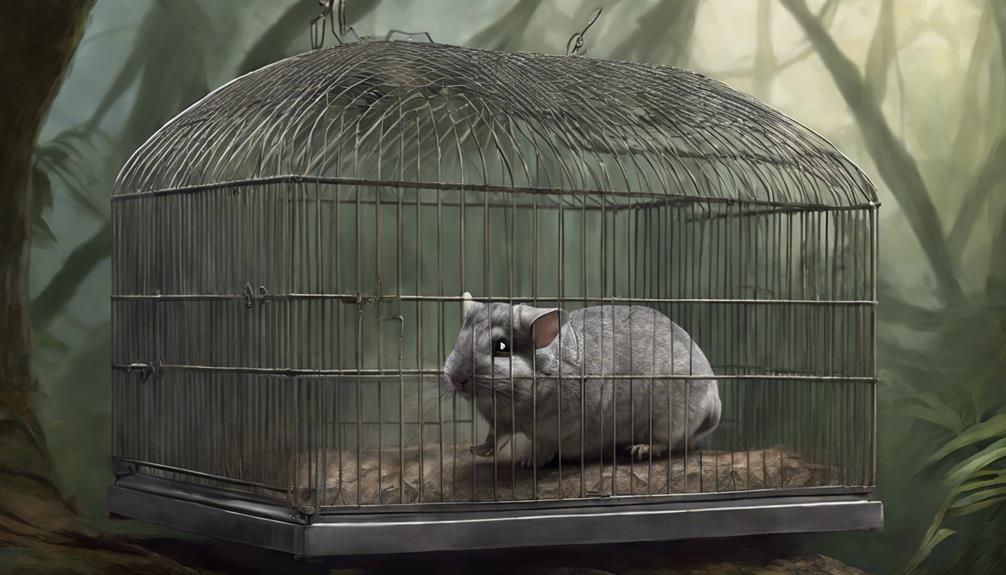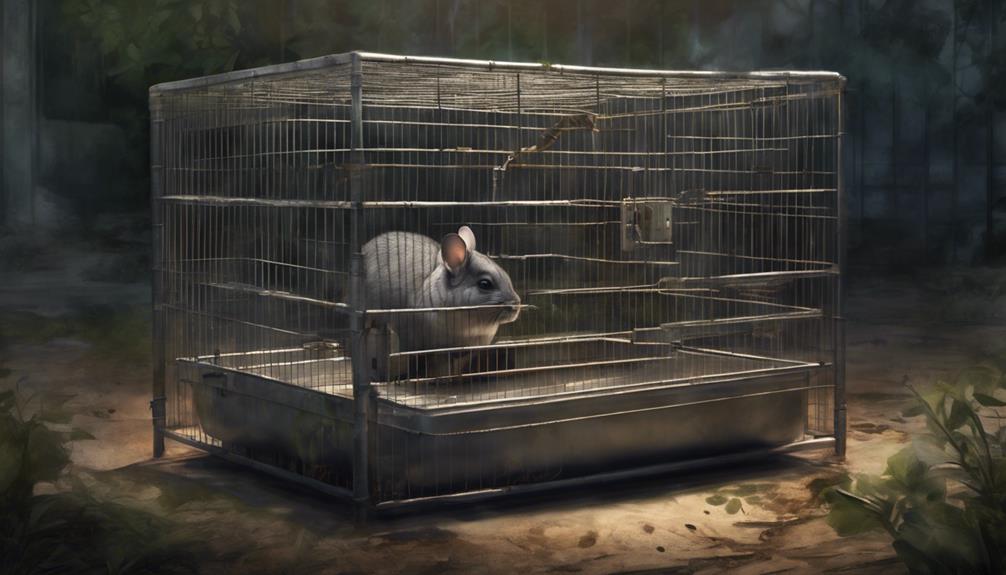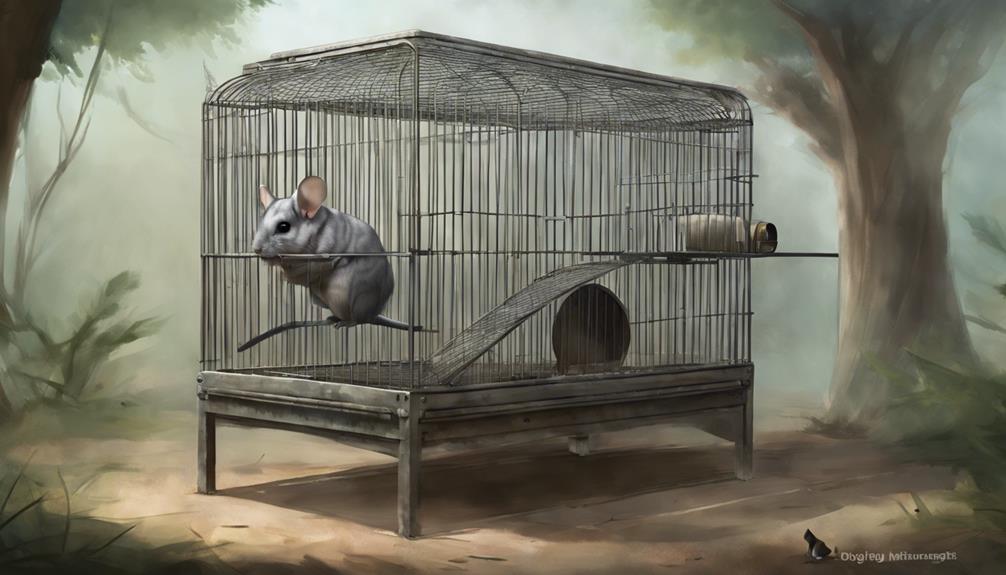How to Safeguard Your Chinchilla's Cage From Predators

Chinchillas are small, vulnerable animals that need protection from potential predators. To safeguard your chinchilla's cage, consider the following tips:
- Choose a secure cage made of sturdy materials to prevent predators from gaining access.
- Place the cage in a safe location, away from areas where predators might lurk, such as near windows or doors.
- Ensure that the cage has a secure locking mechanism to prevent predators from opening it.
- Regularly check the cage for any signs of damage or weakness that could allow predators to break in.
- Provide your chinchilla with plenty of hiding spots and places to retreat to if they feel threatened.
By following these tips, you can help ensure that your chinchilla stays safe and secure in their environment.
Key Takeaways
- Choose a secure cage with sturdy materials and reliable locks
- Place the cage away from predator lurking spots and provide hiding spots
- Ensure proper ventilation and safe location without direct sunlight or drafts
- Have a swift response plan, emergency veterinary contact, and practice evacuation drills
Cage Location
Selecting an appropriate location for your chinchilla's cage is essential for ensuring their well-being and happiness. Cage placement plays a critical role in the overall comfort and safety of your furry companion. When deciding on the ideal spot for your chinchilla's habitat, ventilation considerations should be at the forefront of your mind. Adequate airflow is important to maintain a healthy environment within the cage. Placing the cage in a well-ventilated area helps prevent the buildup of moisture and ammonia, which can be harmful to your chinchilla's respiratory system.
Furthermore, ensuring that the cage isn't exposed to direct sunlight or drafts is equally important. Direct sunlight can cause overheating, while drafts can lead to chills and possible health issues for your chinchilla. Finding a balance between proper ventilation and avoiding extreme environmental conditions is key to providing a comfortable and secure living space for your chinchilla. By carefully considering cage placement and ventilation needs, you're taking a significant step towards safeguarding your chinchilla's well-being.
Secure Locks
When it comes to safeguarding your chinchilla's cage, the importance of secure locks can't be overstated. Different lock types offer varying levels of protection, and proper installation is key to ensuring your pet's safety.
Regular maintenance checks on the locks are essential to prevent any unexpected mishaps.
Lock Types
Ensuring the security of your chinchilla's cage requires choosing a lock type that's both reliable and sturdy. When considering lock types, maintenance and security upgrades play a vital role in safeguarding your pet.
Keyless entry and combination locks are modern solutions that offer convenience without compromising safety. Regular lock maintenance guarantees that your chosen lock type functions at its best, providing peace of mind and a secure environment for your beloved chinchilla.
Security upgrades can further enhance the protection of your pet by adding layers of defense against potential predators. By selecting a lock type that suits your needs and investing in its upkeep, you're actively taking steps to fortify your chinchilla's cage and uphold their freedom within a safe enclosure.
Installation Tips
For a secure lock installation, careful positioning and alignment are essential to guarantee the best functionality and protection for your chinchilla's cage. Predator prevention and cage security hinge on the effectiveness of these locks.
When installing locks on your chinchilla's cage, make certain that they aren't only sturdy but also resistant to tampering. Position the locks strategically, making sure they're out of reach from curious paws or sharp teeth. Take the time to double-check the alignment to prevent any gaps that could compromise security.
Maintenance Checklist
To maintain the security of your chinchilla's cage, diligent upkeep of the locks is essential. Regular inspections and maintenance guarantee that the locks function properly, keeping your furry friend safe from potential predators.
Here are some safety precautions and prevention tips for securing the locks effectively:
- Check for Rust: Regularly inspect the locks for any signs of rust or corrosion that could weaken their effectiveness.
- Test Lock Mechanisms: Make sure that the locks are working correctly by testing their mechanisms periodically.
- Secure Spare Keys: Keep spare keys in a safe place to prevent unauthorized access to the cage.
- Replace Worn-out Locks: If you notice any signs of wear and tear on the locks, replace them promptly to maintain maximum security.
Predator-Proofing Materials
When safeguarding a chinchilla's cage, the choice of predator-proofing materials is paramount. Mesh wire barriers and secure locks are essential components to protect the furry friend from potential threats.
These materials not only provide physical security but also guarantee peace of mind for the chinchilla owner.
Mesh Wire Barriers
Securing your chinchilla's cage with mesh wire barriers is an essential step in protecting them from potential predators. Proper maintenance of the mesh wire is critical to guaranteeing the safety of your beloved pet. Regularly inspecting the barriers for any signs of wear and tear is a wise practice. Additionally, combining the mesh wire with predator surveillance measures can enhance the security of the enclosure. By staying vigilant and proactive, you can create a safe haven for your chinchilla where they can roam freely without fear of outside threats.
- Regularly inspect the mesh wire for damages
- Consider installing additional surveillance cameras near the cage
- Ensure the mesh wire is tightly secured to prevent any gaps
- Seek professional assistance for any necessary repairs or upgrades
Secure Locks
Examining the secure locks on your chinchilla's cage is crucial to strengthening their protection against potential predators. Predator deterrents are vital elements in safeguarding your furry friend. Regular lock maintenance guarantees that these deterrents remain effective in keeping threats at bay.
By paying attention to the condition of the locks, you display a dedication to your chinchilla's safety and well-being. Making certain that the locks are secure and in good working order offers peace of mind, enabling your chinchilla the freedom to roam and play without the risk of harm.
Keep in mind, a well-secured cage not only shields your chinchilla from predators but also fosters a sense of security and tranquility for both you and your pet.
Nighttime Safety Measures

During the night, make sure your chinchilla's cage is securely closed to prevent any potential escapes or disturbances. Nighttime monitoring and predator deterrents are essential for ensuring your chinchilla's safety. Implement the following safety measures to protect your furry friend while they rest:
- Check Locks: Before nightfall, double-check all cage locks to guarantee they're tightly secured.
- Cover Cage: Consider covering the cage with a breathable cloth to provide a sense of security and block out any potential disturbances.
- Avoid Noise: Keep noise levels low around your chinchilla's sleeping area to prevent startling them during the night.
- Dim Lights: Use dim lighting in the room where your chinchilla's cage is located to mimic their natural nighttime environment and promote restful sleep.
Monitoring Systems
As nighttime envelops the domain of your chinchilla's sanctuary, the introduction of monitoring systems becomes a beacon of vigilance and assurance. Surveillance cameras and motion sensors stand as silent guardians, watching over your pet even when darkness veils the world. These technological marvels offer a watchful eye, ensuring that any untoward movement triggers an alert.
In tandem, alarm systems provide an added layer of security, ready to sound the alarm at the slightest hint of danger. The peace of mind afforded by remote monitoring is unparalleled, allowing you to keep a virtual presence even when physically distant from your chinchilla's abode.
Embracing these monitoring systems isn't just a precaution but a proactive step towards safeguarding your beloved pet. The ability to oversee your chinchilla's habitat remotely provides a sense of freedom, knowing that you can always keep a watchful eye on their well-being. In this modern age, technology offers us the tools to protect our furry companions, ensuring their safety and your peace of mind.
Cage Design Considerations

Have you considered how the design of your chinchilla's cage can enhance their safety and well-being? When creating a sanctuary for your furry friend, certain cage design considerations can make a significant difference in their comfort and security. Here are some essential factors to keep in mind:
- Ventilation Options: Ensuring proper airflow within the cage is vital for your chinchilla's respiratory health. Opt for cages with adequate ventilation options to keep the air fresh and clean.
- Design Aesthetics: While functionality is key, don't overlook the importance of design aesthetics. Choose a cage that not only meets your chinchilla's needs but also complements your living space.
- Escape Prevention: Chinchillas are known for their agility and curiosity, making escape prevention a top priority. Select a cage with secure locks and sturdy construction to prevent any unauthorized adventures.
- Cleaning Convenience: Easy cleaning and maintenance are essential for keeping your chinchilla's environment hygienic. Look for cages with removable trays or easy access points to streamline the cleaning process.
Emergency Preparedness
In times of unforeseen challenges, a chinchilla owner's preparedness for emergencies can make all the difference in ensuring their pet's safety and well-being. Predator prevention is a critical aspect of emergency preparedness. By taking proactive measures such as securing the cage with sturdy locks, using predator-proof materials, and placing the cage in a safe location away from potential threats, chinchilla owners can greatly reduce the risk of predators gaining access to their pets.
In the event of an emergency, swift and effective emergency response is essential. Chinchilla owners should have a well-thought-out plan in place, including contact information for emergency veterinary services and a designated evacuation strategy if needed. Regularly practicing this plan can help ensure a quick and calm response in high-stress situations.
Frequently Asked Questions
How Can I Train My Chinchilla to Be More Aware of Potential Predators?
In the wild, chinchillas rely on instinct for predator awareness. Training techniques can reinforce this. Like a wise elder guiding a young one, consistency in lessons helps chinchillas distinguish friend from foe.
Are There Any Specific Plants or Herbs That Can Help Deter Predators From Approaching My Chinchilla's Cage?
In the domain of natural deterrents, certain plants and herbs can aid in predator proofing techniques for chinchilla cages. Lavender, mint, and marigolds are known to repel unwanted visitors, offering a shield of protection for these small, delicate creatures.
Should I Be Concerned About Predators Accessing My Chinchilla's Cage During the Day, or Is Nighttime the Only Time They Pose a Threat?
During the day, predators can still pose a threat to your chinchilla's safety. Daytime vigilance is essential, along with nighttime precautions. Implement predator-proofing strategies and understand chinchilla behavior to make sure your furry friend stays protected at all times.
Are There Any Specific Sounds or Noises That Can Help Scare off Predators From My Chinchilla's Cage?
When it comes safeguarding a chinchilla's cage from predators, it's important ponder sound strategies as noise deterrents. By implementing effective sound cues, one can enhance predator prevention and bolster overall cage security.
What Should I Do if I Suspect a Predator Has Already Gained Access to My Chinchilla's Cage?
If a predator infiltrates a chinchilla's cage, swift action is essential. Prioritize chinchilla safety by ensuring cage security. Immediately remove the chinchilla to a secure location and address the predator threat. Predator prevention and emergency response are paramount.











